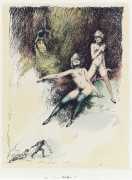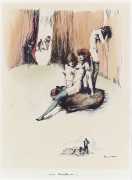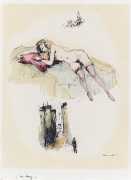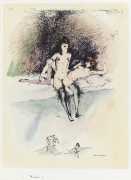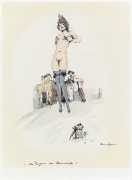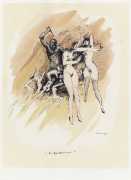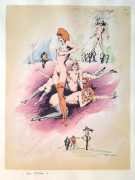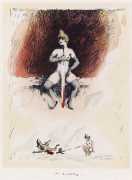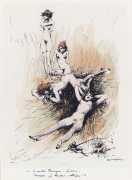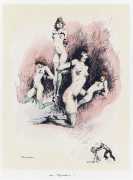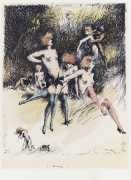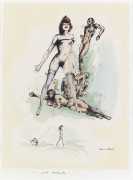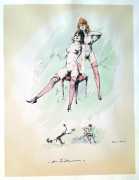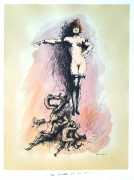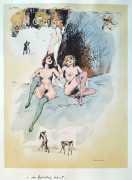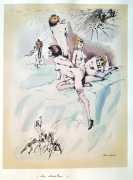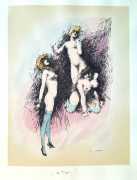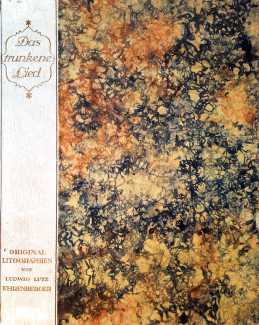 In the realm of the erotic, the most daring Ehrenberger achieved was this 1920 portfolio which takes its title from Nietzsche’s Also sprach Zarathustra (Thus Spoke Zarathustra), and specifically from its best-known passage, Zarathustra’s drunken song with its plea for eternal joy.
In the realm of the erotic, the most daring Ehrenberger achieved was this 1920 portfolio which takes its title from Nietzsche’s Also sprach Zarathustra (Thus Spoke Zarathustra), and specifically from its best-known passage, Zarathustra’s drunken song with its plea for eternal joy.
It is hard to know how seriously to take Ehrenberger’s interpretation – is this a heartfelt cry from the artist’s own experience? We know nothing of his personal life at the time, though living and working in Berlin at the beginning of the freedom-loving Weimar period he must have enjoyed at least some of the available pleasures of the flesh. Or is it merely an opportunity to exhibit his lesbian fantasies, scantily dressed in nothing more than shoes and stockings? Whatever the artist’s motivation, this is a highly original set of prints, well worth careful attention. The engraving is the perfect combination of freedom and control, the hand-colouring delicate and intelligent.
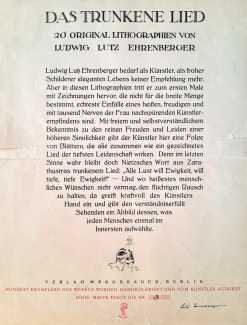 The original introduction sheet to the portfolio is the closest we shall probably get to the artist’s intentions. It reads, ‘As a fine observer of elegant life, Ludwig Lutz Ehrenberger needs no further recommendation as an artist. But in these lithographs he stands out for the first time with drawings that are not intended for the general public, a genuinely joyful artist who can feel woman as if through a thousand nerves. With free and clear insight into the pure joys and sorrows of a higher sensuality, the artist presents us with a series of plates which seen together represent a graphic song of deepest passion. In a very real sense Nietzsche’s words from Zarathustra’s drunken song remain true: “All joy wants eternity – wants deep, deep eternity!” and here Ehrenberger presents a vision of what stirs in the depths of each and every one of us.’
The original introduction sheet to the portfolio is the closest we shall probably get to the artist’s intentions. It reads, ‘As a fine observer of elegant life, Ludwig Lutz Ehrenberger needs no further recommendation as an artist. But in these lithographs he stands out for the first time with drawings that are not intended for the general public, a genuinely joyful artist who can feel woman as if through a thousand nerves. With free and clear insight into the pure joys and sorrows of a higher sensuality, the artist presents us with a series of plates which seen together represent a graphic song of deepest passion. In a very real sense Nietzsche’s words from Zarathustra’s drunken song remain true: “All joy wants eternity – wants deep, deep eternity!” and here Ehrenberger presents a vision of what stirs in the depths of each and every one of us.’
Here is Nietzsche’s text for Das trunkene Lied
O Mensch! Gib acht!
Was spricht die tiefe Mitternacht?
‘Ich schlief, ich schlief –,
Aus tiefem Traum bin ich erwacht: –
Die Welt ist tief,
Und tiefer als der Tag gedacht.
Tief ist ihr Weh –,
Lust – tiefer noch als Herzeleid:
Weh spricht: Vergeh!
Doch alle Lust will Ewigkeit –,
– will tiefe, tiefe Ewigkeit!’
The English translation by Walter Kaufmann
O man, take care!
What does the deep midnight declare?
‘I was asleep –
From a deep dream I woke and swear:
The world is deep,
Deeper than day had been aware.
Deep is its woe;
Joy – deeper yet than agony:
Woe implores: Go!
But all joy wants eternity –
Wants deep, wants deep eternity.’
Each of the plates has an almost indecipherable caption, which may or may not give us some idea of Ehrenberger’s inspiration for the drawing.
1 Das Geschenk (The Gift)
2 Der Cavalier (The Cavalier)
3 Der Zeuge (The Witness)
4 Keine (None)
5 Die Töchter der Steinwüsten (Daughter of the Stony Desert)
6 Der Glücksbringer (The Bringer of Luck)
7 Die Börse (The Marketplace)
8 Der Gerichtstag (Judgment Day)
9 Es werden Schmerzen – Freuden dornen zu Blüten erblühen!
(Pains and Joys will Blossom into Flowers)
10 Der Schrecken (The Scare)
11 Prolog (Prologue)
12 Wird Geschenk (An Offered Gift)
13 Die Blütschen von Lob (Flowers of Praise)
14 Die Spötterinnen (The Taunters)
15 Die Gewalt (Violence)
16 Die Opfer (The Victims)
17 Der freundliche Abend (The Friendly Evening)
18 Das Rad (The Wheel)
19 Ein Meister (A Maestro)
20 Ein Tiger (A Tiger)
Das trunkene Lied was published by M. Proskauer in a limited, numbered and signed edition of 100 copies. It was banned by the Berlin censors in 1936, but by then the edition was sold out, so maybe the banning was simply to make sure that a copy was retained for the police department’s private cabinet.
We are very grateful to Hans-Jürgen Döpp for these images; Hans-Jürgen, the compiler of many books on erotic art, curates the Venusberg online gallery and bookshop which you can find here.


